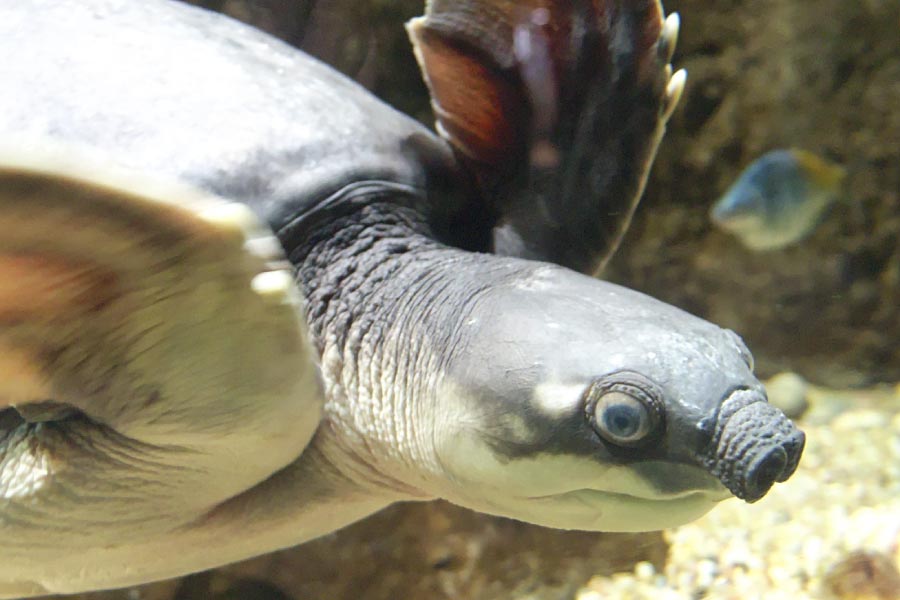Dwelling in the freshwater river systems of Northern Australia and southern New Guinea lies a unique reptile. With its long snout (from which the species gets its name) and webbed flippers, the pig-nosed turtle Carettochelys insculpta–also known as the Fly River turtle–is one of the world’s most distinctive turtles. Sadly, this odd-looking animal is now endangered, mainly due to over-hunting.
Read on to find out more about this distinctive Australian reptile…
Pig-Nosed Turtle Stats
- Other name(s): Fly River turtle
- Scientific name: Carettochelys insculpta
- Length: Up to 70 cm (27.5 inches)
- Weight: Up to 22 kg (48.5 lbs)
- Order: Testudines
- Family: Carettochelyidae
- Where found: Northern Australia and southern New Guinea
- Habitat: Slow-moving freshwater environments, including rivers, lagoons, swamps, and wetlands
- IUCN Conservation status: Endangered
What is a Pig-Nosed Turtle?
The pig-nosed turtle is a freshwater turtle native to the rivers and lagoons of Northern Australia and southern New Guinea. It is the sole member of its family, Carettochelyidae, and related to other soft-shelled turtles in the superfamily Trionychia.
This distinctive reptile is known for its unusual, pig-like snout, which it uses as a snorkel, allowing it to breathe while submerged. Unlike other freshwater turtles, the pig-nosed turtle has true flippers rather than webbed feet.
What Does A Pig-Nosed Turtle Look Like?

The pig-nosed turtle is a distinct and easily recognizable turtle species. As its name suggests, one of its most notable features is its pig-like snout, which is elongated and fleshy, functioning as a snorkel for the turtle to breathe while its body remains submerged.
The turtle has a soft, leathery carapace (shell) rather than the hard, bony one typical of many other turtles. The carapace is typically grey to olive-green in color.
Another distinguishing feature of the pig-nosed turtle is its limbs. Unlike most freshwater turtles, which have webbed feet, the pig-nosed turtle’s limbs are flippers that are more reminiscent of marine turtles. These paddle-shaped flippers are powerful and efficient for swimming.
The turtle’s overall size is relatively large, with adults often reaching a shell length of over 70 cm (27.5 inches) and weighing up to 22 kg (48.5 lbs). The combination of its unique snout, soft shell, and paddle-like limbs makes the pig-nosed turtle one of the most distinctive turtles in the world.
Where are Pig-Nosed Turtles Found?
The pig-nosed turtle is native to a relatively restricted range, primarily found in the freshwater systems of Northern Australia and southern New Guinea.
In Northern Australia, the species’ range encompasses the rivers of the Northern Territory, such as the Daly and Alligator Rivers.
In southern New Guinea, the pig-nosed turtle inhabits the Fly River system and nearby areas.
Habitat
The pig-nosed turtle prefers slow-moving, warm freshwater environments. This includes rivers, lagoons, swamps, and wetlands. These habitats offer abundant food and the soft, sandy riverbeds that are essential for the turtle’s nesting process.
Pig-Nosed Turtle Diet

The pig-nosed turtle is omnivorous. Plant matter forms the bulk of its diet. This includes the leaves and stems of water plants, and fruits, nuts and seeds that have fallen into the water.
Animals eaten by the turtle include mollusks, crustaceans such as shrimp and small crabs, various aquatic insects, and small fish.
The pig-nosed turtle’s strong jaws allow it to handle a variety of foods, from soft aquatic plants to the harder shells of crustaceans.
Pig-Nosed Turtle Family And Related Species
The pig-nosed turtle is the only living member of the family Carettochelyidae. This family, along with the soft-shelled turtles of family Trionychidae, make up the superfamily Trionychia.
Trionychia is part of a larger group of turtles, the suborder Cryptodira, or “hidden-neck” turtles. Turtles in this group withdraw their heads straight back into their shells.
(Turtles belonging to the other main turtle group, the suborder Pleurodira, or “side-necked” turtles, bend their necks sideways to hide their heads in their shells.)
Pig-Nosed Turtle Life Cycle & Lifespan
Female pig-nosed turtles lay their eggs in sandy riverbanks. They typically choose soft, sandy soils to dig their nests, which can be quite deep. Clutch size ranges from 8 to 48 eggs.
The eggs incubate for a period of about 3 to 4 months, with hatching usually being delayed until the start of the rainy season. The sex of the hatchlings is temperature-dependent; higher temperatures tend to produce females, while lower temperatures produce males.
The hatchlings make their way to water, during which time they are highly vulnerable to predators like birds and fish.
The pig-nosed turtle reaches sexual maturity around the age of 16 to 18 years.
Throughout their life, pig-nosed turtles remain mostly aquatic, venturing onto land primarily for nesting. Their lifespan in the wild is estimated to be around 20 to 30 years, though they can live longer in captivity.
Is the Pig-Nosed Turtle Endangered?
The pig-nosed turtle is an endangered species with a decreasing population. The main threat to the turtle is over-exploitation by indigenous peoples, who hunt the turtle both for its meat, and for its eggs, which are harvested in large numbers.
A secondary threat is habitat loss; activities like logging, mining, and agricultural development have led to the destruction and alteration of the turtle’s freshwater habitats.

